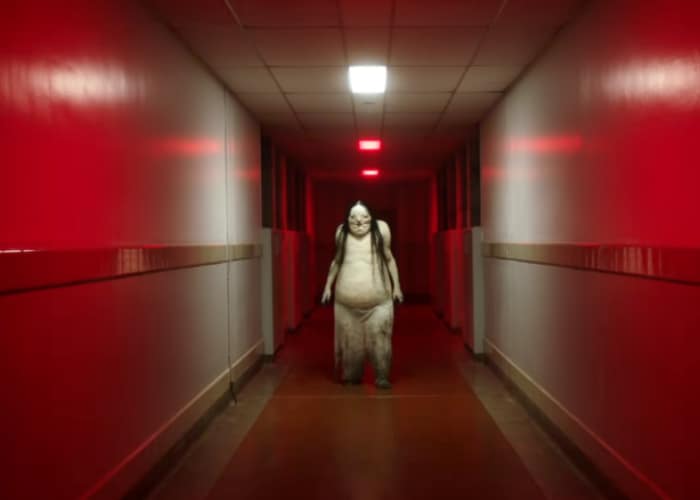Everyone can remember their first brush with Scary Stories to Tell in the Dark. The cover image of a head resembling a clown skull, with exaggerated features and red-colored nose, inexplicably rising from the ground, was a preview of the terrors to be found within the pages of the first book.
The literary series by author Alvin Schwartz and initially featuring drawings from Stephen Gammell has scarred children since its debut in 1981, its stature growing through the years as a tomb that must be passed down from generation to generation. The fiendish illustrations and foreboding tales beg to be shared with others. Tucked away in the children’s section at libraries or found at book fairs, Scary Stories to Tell in the Dark gave many children their first glimpse into horror.
Strengthening their legacy has been the outcry to condemn them. The appearance of the series on many banned book lists through the last three decades has only improved sales. After all, children love things that are inappropriate. Cody Meirick, director of the new documentary Scary Stories, claims in an interview with Inverse, “Schwartz really loved the fact that his books were being banned. The attention to censorship within schools and libraries was just beginning to take shape around the time of his passing in the early 1990s. The American Library Association really started tracking and making lists in the mid-1980s, which was when his books began to really take off. But Alvin loved it and thought it was great publicity.”
Although many children loved the books, parents did not. Whether it was because of the gruesome nature of the stories or Mom and Dad being burdened with sleepless nights from frightened children, the books were often challenged. In fact, the American Library Association named Scary Stories to Tell in the Dark as the book most challenged by parents in the 1990s. Some of the other more frequent titles that appear on the list today are the Harry Potter and His Dark Materials series as well as The Hate U Give and I Know Why the Caged Bird Sings.
Scary Stories was primarily deemed inappropriate for its depiction of violence and negativity. In a 1993 interview with the Chicago Tribune, former elementary schoolteacher Sandy Vanderburg offered her comments about the material: “If these books were movies, they’d be R-rated because of the graphic violence. There’s no moral to them. The bad guys always win.” Scary Stories is still frequently challenged to this day and there is always concern over the content.
Even more effective than the stories themselves, though, was the accompanying artwork by Gammell. There is something very unsettling about those black and white images. Show any Millennial an image from that series and they will quickly be able to recollect where they saw it. Some examples: Sam’s New Pet, which features a grotesque sewer rat; The Red Spot with its portrait of a young woman with spiders crawling out of her cheek — spiders are already high on many people’s fear lists, but this takes it to another level. And Harold is an eery shot of a scarecrow. He looks as though he’s hanging with a noose around his neck, and his stiched up stomach adds to the unnerving feeling you get while looking at him.
When Scary Stories to Tell in the Dark was reissued for its 30th anniversary in 2011, HarperCollins replaced the drawings. A new artist, Brett Helquist (A Series of Unfortunate Events), was hired to placate some of the complaints about the books. Gone were the images that kept children up at night, replaced with much tamer illustrations to accompany the stories. The blowback was immediate. How could anyone censor those devilish designs? Scary Stories to Tell in the Dark is a synergy of text and illustration, and separating them was akin to stepping on one’s childhood.
Amazon reviews showed the frustrations with the changes: “These might be better toned down for your (boring) children, but if you were hoping to reminisce about the terrors of your childhood, you’ll have to look elsewhere,” said one. “You’ll be missing out on part of what made these books as wonderful in the first place,” another said. Websites started presenting the new images side-by-side with the originals, and it was hard to be enthusiastic about the difference. There’s something beautiful and horrific about the Gammell drawings. Thankfully, in 2017, the books were reissued in a collection with the original art.
The first rumblings of a film adaptation were announced before then, at the end of 2013, and three years later, Guillermo del Toro was attached to the project as a writer and producer. He shared his love for the books during press junkets. “When I first saw the cover of Scary Stories Vol.1, it was astounding,” he told Vulture this summer. He was so impressed and influenced by the drawings that he purchased nine of Gammell’s illustrations from the books.
Del Toro wanted to make sure that the feeling of seeing those creatures in the book came across on the big screen. In a promotional video for Fandango, he expresses his concept for bringing Scary Stories to Tell in the Dark to life: “[We wanted] to emulate, with the creatures, the black and white feeling of the illustrations in the book. We knew we wanted them drained of color.”
Now, with del Toro and director André Øvredal evoking that original artwork for the creature designs of the movie, audiences can appreciate that banned and censored imagery anew. And the longtime fans get to cinematically re-experience the monsters that haunted their dreams long ago and maybe even relive some of their old nightmares.

